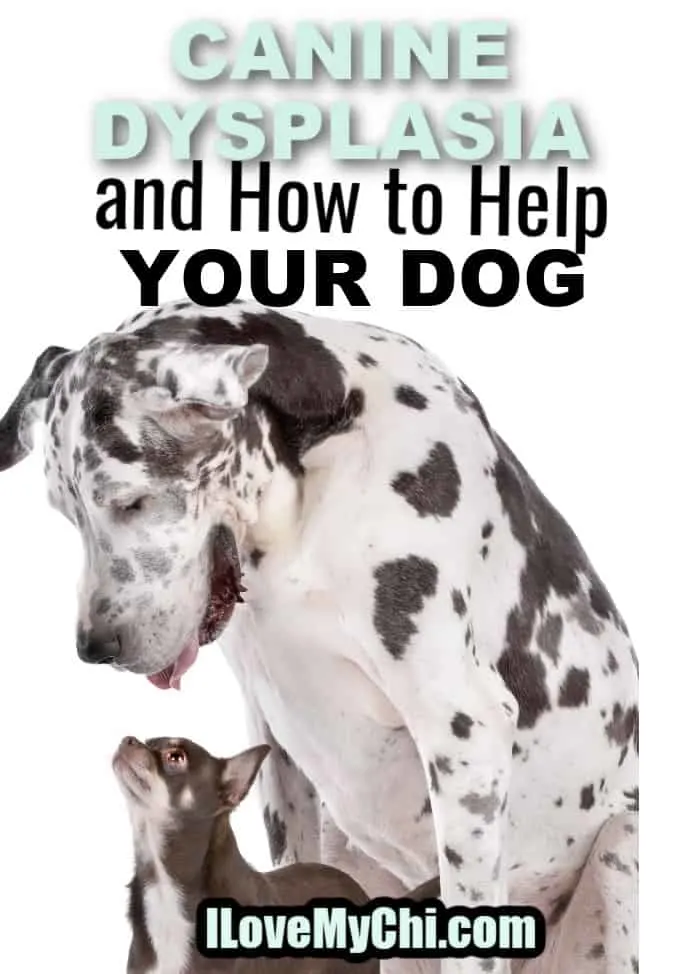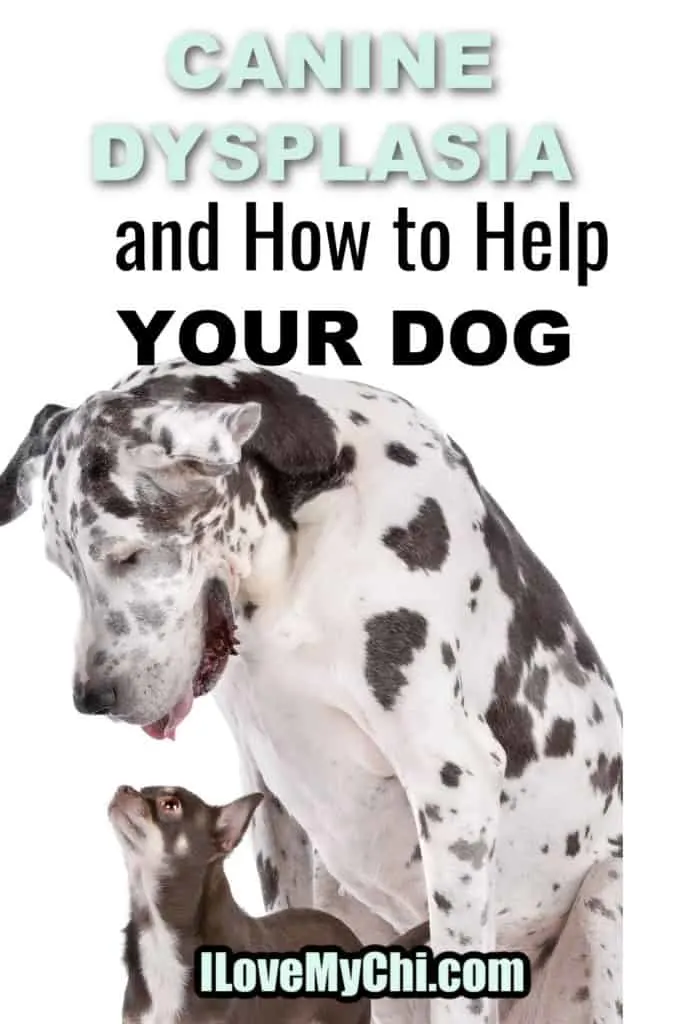I got my Ziggy at 3 months old and when I had the vet check him out, they told me he had hip dysplasia. He said it was fine now but as he aged it may become a problem. My elderly large dog Roxy had this too so I do have some knowledge about it. I want to share this knowledge with you.

Hip dysplasia in dogs is usually a genetic condition that occurs due to abnormal hip joint development in a young dog. Though most dogs that suffer from hip dysplasia are born with it, sometimes perfectly healthy dogs suddenly develop it as they grow up. Hip dysplasia causes the soft tissues that surround the hip joints to weaken, and the ligament that would normally hold the hip in its socket gets stretched out, causing bone separation at the hip.
Hip dysplasia can occur in just one hip or both. Larger dog breeds are the most susceptible to this disease, occasionally medium size dogs suffer from this disease also. Smaller breeds are less likely to acquire hip dysplasia but Ziggy weighs 5 pounds and has it so it does happen. Mixed breed dogs are less likely to get hip dysplasia than pure breed dogs. Some of the breeds most commonly affected by hip dysplasia are; Great Danes, Pit Bulls, Rottweilers, German Shepherds, St. Bernard’s, Labrador, and Golden Retrievers.
What Causes Hip Dysplasia?
Vets agree that a dog’s genetics can play a definite role in whether or not your dog gets hip dysplasia. Dogs whose parents had hip dysplasia are much more likely to acquire the disease than other dogs. There are other factors also that can put a dog with no genetic history of the disease at risk. A dog’s diet and nutrition can play a major role. Dogs that are obese have a much higher risk of developing hip dysplasia than healthy dogs. Also, dogs that have excessive calcium intake, rapid weight gain, and poorly formulated diets are at increased risk.
How to recognize the symptoms of hip dysplasia in your dog.
The symptoms of hip dysplasia in dogs are similar to the symptoms of osteoarthritis. Your dog will exhibit stiffness and pain in their rear legs after exercise or first thing in the morning. Some dogs will limp or walk and run differently, often in a kind of a bunny hopping motion. Many will have issues with getting upright from a lying down position or have trouble navigating stairs, getting on and off couches or beds, and some may even moan, whine, or yelp with a sudden movement of their rear legs.
Dogs of any age can display the symptoms of hip dysplasia. Some dogs show symptoms while they are still puppies, (usually between 6-12 months of age), while others don’t show signs until adulthood or even old age. Older dogs are often misdiagnosed as just having arthritis when it is actually hip dysplasia. X-rays and other medical tests can tell the difference, so if your dog displays these symptoms, please take the dog to the vet.
How is Dog Hip Dysplasia Diagnosed?
A veterinarian can diagnose hip dysplasia with a simple x-ray of the pelvis and a physical exam.
What Treatments are available for dogs with Hip Dysplasia?
There are many different treatments for this disease in dogs. Most dogs can be treated non-surgically as long as the disease is discovered before too much damage has occurred to the hip joint. It is up to the dog owner to choose which treatments to use for their dog. Often a dog requires a combination of treatment options.
Weight Management:
If the dog is over-weight, it makes the pain and symptoms of hip dysplasia worse. Getting over-weight dogs on a healthy diet until they are at a healthy weight will greatly improve the dog’s symptoms.
Exercise

Getting regular dog exercise to the affected joint can help increase blood flow to the area as well as strengthen other muscles to take up the slack of the diseased area. Gentle exercise is best like swimming, walking, and gentle play.
You can also consider consulting with a veterinary professional specializing in rehabilitation to help guide exercise therapy.
Massage Therapy
Regularly massaging the affected area on the dog also increases blood flow, relieves tension, and just feels darned good to your dog!
Keeping your dog warm
Cold affects hip dysplasia, just like it affects arthritis. Make sure your dog has a warm and comfortable place to sleep, keep your dog indoors in very cold weather, and if it’s cold outside, put a sweater on your dog before taking it out for a walk.
Consider getting a memory foam bed to keep your dog off the hard, cold floor.
Make Your Dogs Life Easier
Using stairs and jumping up and down to get on and off couches and beds or in and out of cars can cause a lot of pain for a dog with hip dysplasia. Building or purchasing a ramp for outside stairs can really help. There are quite a variety of collapsible doggie ramps available.
Oral Supplements for Dogs
There are quite a few natural and healthy oral supplements available for dogs that can really do wonders for pain relief due to hip dysplasia or arthritis. Here is a list of supplements that help hip dysplasia:
- Glucosamine
- Chondroitin
- Omega-3 Fatty Acids
- Duralactin
- MSM (Methyl-Sulfonyl-Methane)
- Creatine
- Perna Mussels
- Vitamin C
There are even more than that, but these are the most popular; check with your vet to find the right supplements for your dog
Anti-Inflammatory Drugs
There is a lot of controversy about giving these drugs to dogs. Different vets have different opinions. See what you vet recommends, then do your own research before making a decision. Our dog was on daily anti-inflammatory drugs before we discovered the glucosamine. Since she started taking that, she no longer needs the drugs.
There are many different anti-inflammatory drugs available for dogs. Some are in edible pill form; others are pills that need to be crushed or hidden in foods, and some need to be injected into the dog. Always check with your vet before starting any drug therapy.
Surgical Procedures
There are some different surgical options for dogs with very severe hip dysplasia. Hip replacement surgery is a popular option. Surgical solutions for dog hip dysplasia are used when the disease is severe enough to cause pain that is challenging to control.
You can help your dog with hip dysplasia avoid surgery by recognizing the symptoms early and keeping your dog nutritionally healthy and at the proper weight while making sure your dog gets regular exercise.
Have you ever had a dog that suffers from hip dysplasia? Tell us about your experiences and what helped or didn’t help your dog in the comments.

/

Paula Simons
DVM
This article has been reviewed, fact-checked, and approved by Dr. Paula Simons DVM. You can read more about her on our About page.


Valerie Manon
Friday 9th of July 2021
Love your new baby. He's beautiful.
Cathy
Friday 9th of July 2021
Thanks Valerie!